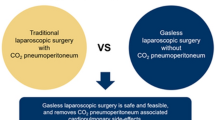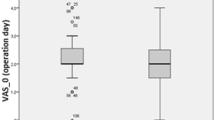Abstract
Background
Because of absorbed carbon dioxide (CO2) and elevated intraabdominal pressure (IAP), CO2 pneumoperitoneum (CO2PP) has potentially harmful intraoperative circulatory and ventilatory effects. Although not clinically significant for healthy patients, these effects are assumed to be deleterious for patients with a high risk for anesthesia (American Society of Anesthesiology [ASA] 3 and 4) and significant cardiopulmonary, renal, or hepatic diseases. The authors assessed CO2PP-related adverse effects by comparing ASA 3 and 4 patients who underwent laparoscopic cholecystectomy (LC) with or without CO2PP.
Methods
A total of 20 successive ASA 3 and 4 patients who underwent LC were randomized into CO2PP (n = 10) and abdominal wall elevator (Laparolift) (n = 10) groups. The parameters for perioperative hemodynamics, ventilation, perfusion of intraabdominal organs, and blood chemistry were recorded periodically from before the induction of the anesthesia until postoperative day 2 and compared between the groups.
Results
Mean age, height, weight, the proportional number of ASA 3 vs ASA 4 patients, the volume of perioperative fluid loading, and the dose of analgesics did not differ significantly between the groups. The length of the operation was 49.9 ± 10.6 min for the CO2PP group and 50.6 ± 17.2 min for Laparolift group (nonsignificant difference). The mean central venous pressure (CVP) 30 min after insufflation was higher (12.3 ± 4.8 vs 7.9 ± 3.7 mmHg) and the (Gastric Mucosal pH) pHi at the end of the operation was lower (7.29 ± 0.07 vs 7.35 ± 0.04) in the CO2PP group than in the Laparolift group (p < 0.05). Later, CVP and pHi did not differ significantly. Other parameters of hemodynamics including oxygenation, perfusion, and blood chemistry did not differ significantly.
Conclusions
For LC for patients with an ASA 3 and 4 risk for anesthesia, no significant adverse effects could be attributed to CO2 pneumoperitoneum. For high-risk patients, preoperative preparation and active perioperative monitoring are essential for safe anesthesia for LC with or without CO2PP.
Similar content being viewed by others
References
Bardoczky GI, Engelman E, Levarlet M, Simon P (1993) Ventilatory effects of pneumoperitoneum monitored with continuous spirometry. Anaesthesia 48: 309–311
Carry PY, Gallet D, Francois Y, Perdrix JP, Sayag A, Gilly F, Eberhard A, Banssillon V, Baconnier P (1998) Respiratory mechanics during laparoscopic cholecystectomy: the effects of the abdominal wall lift. Anesth Analg 87: 1393–1397
Galizia G, Prizio G, Lieto E, Castellano P, Pelosio L, Imperatore V, Ferrara A, Pignatelli C (2001) Hemodynamic and pulmonary changes during open, carbon dioxide pneumoperitoneum and abdominal wall-lifting cholecystectomy: a prospective, randomized study. Surg Endosc 15: 477–483
Harman PK, Kron IL, McLachlan HD, Freedlender AE, Nolan S (1982) Elevated intraabdominal pressure and renal function. Ann Surg 196: 594–597
Hasukic S (2005) Postoperative changes in liver function tests: randomized comparison of low- and high-pressure laparoscopiccholecystectomy. Surg Endosc 19: 1451–1455
Hirvonen EA, Nuutinen LS, Kauko M (1995) Ventilatory effects, blood gas changes, and oxygen consumption during laparoscopic hysterctomy. Anesth Analg 80: 961–966
Joris JL, Noirot DP, Legrand MJ, Jacquet NJ, Lamy ML (1996) Hemodynamic changes during laparoscopic cholecystectomy. Anesth Analg 76: 1067–1071
Junghans T, Modersohn D, Dorner F, Neudecker J, Haase O, Schwenk W (2006) Systematic evaluation of different approaches for minimizing hemodynamic changes during pneumoperitoneum. Surg Endosc 20: 763–769
Kendall A, Bhatt S, Oh T (1995) Pulmonary consequences of carbon dioxide insufflation for laparoscopic cholecystectomies. Anaesthesia 50: 286–289
Knolmayer TJ, Bowyer MW, Egan JC, Asbun HJ (1998) The effects of pneumoperitoneum on gastric blood flow and traditional hemodynamic measurements. Surg Endosc 12: 115–118
Koivusalo AM, Kellokumpu I, Ristkari S, Lindgren L (1997) Splanchnic and renal deterioration during and after laparoscopic cholecystectomy: a comparison of the carbon dioxide pneumoperitoneum and the abdominal wall lift method. Anesth Analg 85: 886–891
McLaughlin J, Scheeres D, Dean R, Bonnell B (1995) The adverse hemodynamic effects of laparoscopic cholecystectomy. Surg Endosc 9: 121–124
Meierhenrich R, Gauss A, Vandenesch P, Georgieff M, Poch B, Schutz W (2005) The effects of intraabdominally insufflated carbon dioxide on hepatic blood flow during laparoscopic surgery assessed by transesophageal echocardiography. Anesth Analg 100: 340–347
Meininger D, Byhahn C, Mierdl S, Westphal K, Zwissler B (2005) Positive end-expiratory pressure improves arterial oxygenation during prolonged pneumoperitoneum. Acta Anaesthesiol Scand 49: 778–783
Miki Y, Iwase K, Kamiike W, Taniguchi E, Sakaguchi K, Sumimura J, Matsuda H, Nagai I (1997) Laparoscopic cholecystectomy and time course changes in renal function. Surg Endosc 11: 838–841
Morino M, Giraudo G, Festa V (1998) Alterations in hepatic function during laparoscopic surgery: an experimental clinical study. Surg Endosc 12: 968–972
Neudecker J, Sauerland S, Neugebauer E, Bergamaschi R, Bonjer HJ, Cuschieri A, Fuchs KH, Jacobi C, Jansen FW, Koivusalo AM, Lacy A, McMahon MJ, Millat B, Schwenk W (2002) The European Association for Endoscopic Surgery clinical practice guideline on the pneumoperitoneum for laparoscopic surgery. Surg Endosc 16: 1121–1143
O’Leary E, Hubbard K, Tormey W, Cunningham A (1997) Laparoscopic cholecystevtomy: haemodynamic and neuroendocrine response after pneumoperitoneum and changes in position. Br J Anaesth 76: 640–644
Paolucci V, Gutt CN, Schaeff B, Encke A (1995) Gasless laparoscopy in abdominal surgery. Surg Endosc 9: 497–500
Rademaker BM, Meyer DW, Bannenberg JJ, Klopper PJ, Kalkman CJ (1995) Laparoscopy without pneumoperitoneum: effects of abdominal wall retraction versus carbon dioxide insufflation on hemodynamics and gas exchange in pigs. Surg Endosc 9: 797–801
Sato K, Kawamura T, Wakusawa R (2000) Hepatic blood flow and function in elderly patients undergoing laparoscopic cholecystectomy. Anesth Analg 90: 1198–1202
Schilling MK, Redaelli C, Krahenbuhl L, Signer C, Buchler MW (1997) Splanchnic microcirculatory changes during CO2 laparoscopy. J Am Coll Surg 184: 378–382
Struthers AD, Cuschieri A (1998) Cardiovascular consequences of laparoscopic surgery. Lancet 352: 568–570
Thoelke MH, Merkelbach D, Ehmann T, Henrich P, Engelhardt GH, Brandt L (1995) The abdominal lift: is there any advantage for the critically ill patient? Endosc Surg Allied Technol. 3: 180–182
Windberger UB, Auer R, Keplinger F, Langle F, Heinze G, Schindl M, Losert UM (1999) The role of intraabdominal pressure on splanchnic and pulmonary hemodynamic and metabolic changes during carbon dioxide pneumoperitoneum. Gastrointest Endosc 49: 84–91
Wittgen C, Andreus C, Fitzgerald S, Baudendistel L, Dahms T, Kaminski D (1991) Analysis of the hemodynamic and ventilatory effects of laparoscopic cholecystectomy. Arch Surg 126: 997–1001
Author information
Authors and Affiliations
Corresponding author
Rights and permissions
About this article
Cite this article
Koivusalo, AM., Pere, P., Valjus, M. et al. Laparoscopic cholecystectomy with carbon dioxide pneumoperitoneum is safe even for high-risk patients. Surg Endosc 22, 61–67 (2008). https://doi.org/10.1007/s00464-007-9300-2
Received:
Revised:
Accepted:
Published:
Issue Date:
DOI: https://doi.org/10.1007/s00464-007-9300-2




